
|   |

|   |
 e-mail: leelakaverivenkat@gmail.com Nrityantar's Naman 2024 an interactive delight Photos: Srivatsa Shandilya September 16, 2024 In the present dance scenario, the performance aspect has assumed such pre-eminence, that interactions on dance between artistes, dance writers, and audiences have become too few and far between. It is in blending performance with the educational benefits of interaction with various agencies concerned with the dance, that the two-day event Naman 2024 (an annual event), hosted by Nrityantar, the Odissi school of Bangalore based artiste Madhulita Mohapatra, deserves high praise for. The present fad of chief guests of various denominations presiding over dance presentations, invited on to the stage for lamp lighting, garlanded and honoured with decorative shawls, (causing a further dent in the already slender purses of dance institutions) and requested 'to say a few words' during or after the show, aside from adding to the snob value and public relations of the person heading the institution, contributes little to the average participating dancer. This is where dancer Madhulita scores by having cozily informal morning sessions in her home/school where all the invited chief guests comprising poets, artistes, musicians, writers, critics et al, engage in a vibrant exchange with the students present - the lively statements, repartees, opinions, and personal anecdotes adding up to rich art information - for which the students, already weighed down by studies, would need to go to several libraries and sources. In this easy atmosphere one even had a film song in a melodious baritone sung by one of the guests Abdul Lateef Naha! This general knowledge through a pleasurable interchange with queries from the students too, over two hours or more, constitutes an exchange worth its weight in gold for a dance student. Madhulita's school obviously keeps in touch with other educational institutions too and on the last day, in collaboration with Nrityantar, the Symposium at the Department of Communications Mount Carmel College, with all the chief guests participating on the occasion of The Sunil Kothari Memorial in Colloquium 2024 on Classical Dance, involving dancers, commentators and audiences, marked the right conclusion for hectic activity over three days. And what a variety of viewpoints were expressed! Sahana Das conducted the proceedings ably. Who better than V.V. Ramani who apart from his art expertise in collages and paintings, works with textile, costume and set designing, including writing on dance, to answer a question on how art disciplines contribute, and in turn are contributed by one another. When it comes to talking about trying out new themes and concerns expressed in dance, few could be more informed than Kedar Misra - editor, poet, journalist, art critic with a caustic, bold pen and human rights activist - whose weekly column Sesasparsha has earned a wide readership. Why this obsession with Nayikas and Nayaks ? Why not Prati Nayak, he demands, scoffing at all the prescribed standards in our Sastras, with an obsessive involvement with idealized states-of-being, when real life is so different! Adding fuel to the critical fire was Roma Singh, Assistant Editor, The Indulge Magazine of the New Indian Express, with his theory that adverse criticism which discourages dancers needs to be replaced by more of the reportage kind of writing in order to attract more youngsters into art fields. A point of view which was shared by Abdul Lateef Naha, journalist with the Hindu newspaper, Palakkad and Malappuram region. 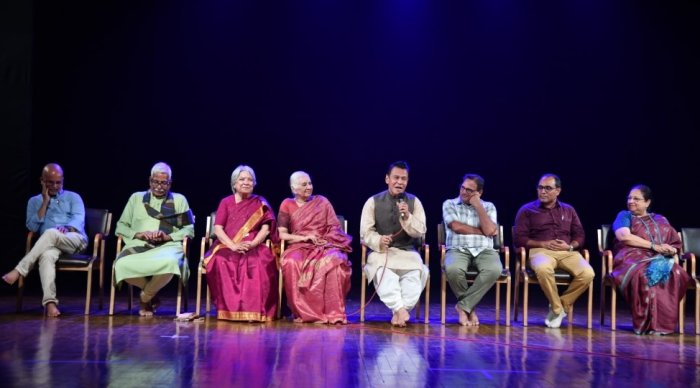 Panel Malaysian dancer of Odissi, Datuk Ramli Ibrahim, politely wondered if such banning of critical writing would not encourage sub-standard fare. It was interesting to listen to how he reconciled his dance career In Odissi which specialized in Hindu themes, as a foreigner belonging to the Islamic faith, earning encomiums in both his own country and the one his art belonged to. Dance writer Tapati Chowdhurie spoke at length about art developments with reference to art pioneers like Tagore and Uday Shankar. My indirect references, touched upon ethics of dance criticism, responsibility of a critic and what professional integrity meant. Ultimately critical writing needs to communicate powerfully with the reader - and rather than displaying the writer's erudition with too many technical terms, needs to get the message of art excellence across. Watching and developing an eye are a must for any arts writer. In the final analysis, there can be no last word spoken or written, on dance. A student in the auditorium referred to the current high tone of bitter exchange with insular approaches surrounding the Devadasi's Sadir (practiced in temple and court), as against its 'appropriated form' by non-inheritors, to quote some scholars, in its repositioned version as Bharatanatyam, for the proscenium. In a free country, it is for each person to decide what one vibes with. Only fact is that going back in history is not easy, and if one prefers the earlier form, and is able to get able teachers, all luck to the person. After all, Swapna Sundari slogged to bring back the Andhra Devadasi's art - now called Vilasini Natyam and many types of compositions never a part of the traditional Bharatanatyam repertoire, have become part of presentations - including Bharatanatyam rendered to Bhojpuri songs! Ultimately one has to carry the audience along, and what one presents has to have conviction. This critic mentioned how Prati Nayak, choreographed by Aruna Mohanty and scripted by Kedar Misra, which evoked thunderous standing applause in one venue in Chennai, failed to create similar enthusiasm amongst the Music Academy audience - a typical instance of audience responses also dictating trends. But in my opening remarks I had mentioned that pursuit of all arts and some other disciplines too, help foster a feel for harmony, creating a balanced human being. The critic, while politely standing up for one's convictions, will also have to take criticism in the stride and not expect to win personality contests. At best, one may earn a grudging respect from the majority.  Reshmi Divakaran in Dheera Sameere 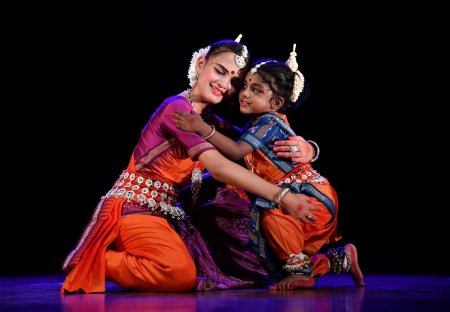 Kede Chhanda 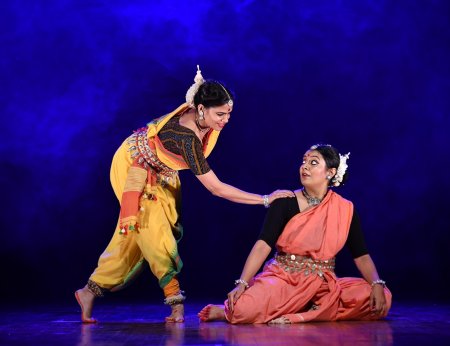 Madhulita Mohapatra & Anjali Raj Urs in Priye Charushile 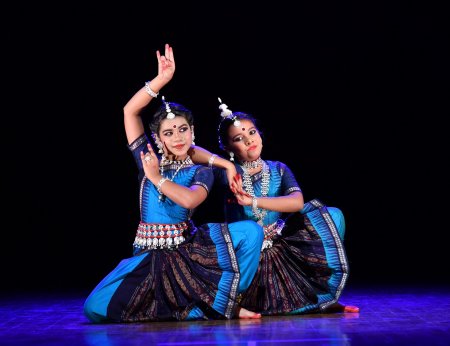 Radha Rani As for the performance side, students of Nrityantar acquitted themselves creditably - the sheer joy in the dance of each performer, being teacher Madhulita's greatest achievement. Grace filled movements, clean in terms of technique and rhythm, with good group discipline, students both senior and junior gave proof of painstaking training. A programme comprising Darbari Pallavi, ashtapadis Dheera Sameere, Yahi Madhava, Priye Charushile, known Odiya compositions like Kete chhanda Janilo sahi Nanda rajare Tiki Pillati, Radha Rani sange nache and the very poetic Varsha Avisar with music by Ramahari Das and Aruna Mohanty's choreography, with its play on the word Barosa (Varsha) Rasa, with compositions based on gods from the Sringeri Shankaracharya pantheon like Sharada Bhujangam Ashtakam and homage to Shiva, Shivam Dhimahi, with Sukant Kundu's music, including a Kannada composition (effect of courtesy being based in Bangalore) of Purandhara Dasa, Hari Smarana Mado rendered by Madhulita herself, the first day's Naman offer provided rich variety, with both group and solo well represented. Dancers were well chosen in the solo items suiting their personalities - like Reshmi Divakaran presenting Dheera Sameere, and Sahana Raghavendra presenting the more forceful Sharada Bhujangam, while Yahi Madhava was presented by Meghna Das, with Anjali Raj Urs presenting Varsha Avisar. 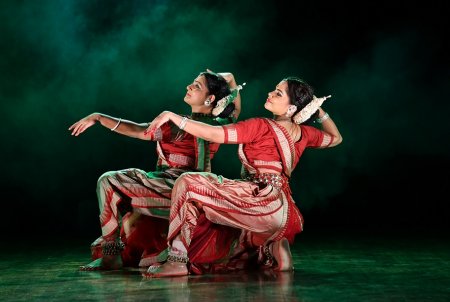 Siya Ram 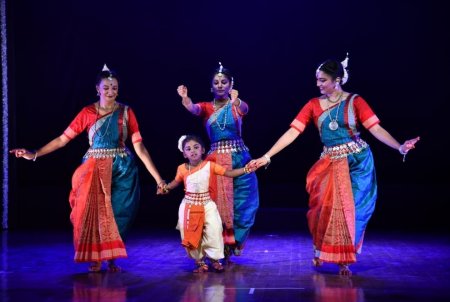 The next evening's dance drama 'Siya Ram - The Eternal Saga' was based on a blended script from Ashtavadhani, Ganesh Bhat Koppalatota, and Odiya poet Kedar Mishra. Music composition was by Rupak Kumar Parida, with rhythmic input by Dhaneswar Swain. Madhulika's sensitive choreography, once again in the choice of dancers for the various roles, in what was a fast moving production with no room for prolonged sequences, showed a knack for picking the right dancer. 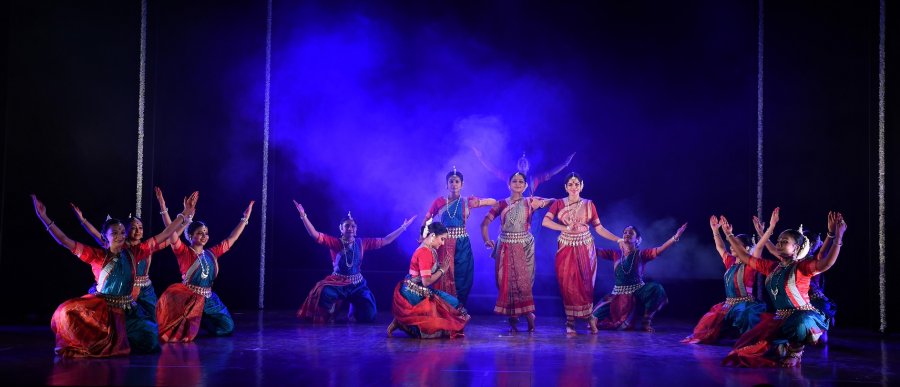 Siya Ram Reshmi Divakaran played Rama to Madhulita's Sita. Lakshmana found the right dancer in Nandhana Sashikumar, and Sahana Raghavendra Maiya filled the role of Ravana ably. In the very typical roles in the story as Hanuman, Jatayu and Manthara were Aditi Das, Prishna Sinha and Dr. Anupama Kumar. Nandana Sashikumar as Kaikeyi, Sumana Das as Dasaratha, and Soni Tarasia as Surpanakha filled their roles convincingly. Angelina Avnee with her graceful, light footed jumps, made a very convincing Mareecha. While no dancer was a star in her own right, as amateurs the group combined with excellent understanding, without a hint of any deviant presentations. Altogether a laudable exercise! And what a delightful three year old daughter of Madhulita, Mihika (not yet being formally trained), but with a precocious rhythmic sense and understanding of stage space, who in the group scenes as child Rama, and in the scene with the monkeys, joined in, falling in line with the others, without a hint of stage self-consciousness. Like all exceptionally sharp youngsters, she shows great promise which has to be handled with care. Ramli Ibrahim's troupe comprising just three of his students from Sutra, Geetika Sree, Tan Mei Mei and Vikneswaran, with Ramli coming in for short stints along with the announcements, illustrated, in a power-packed recital, the persuasive strength of Guru Debaprasad's Odissi style, with its interlocked passages of Sabda Swara Patha, narrative snippets with percussion syllables, very much a part of the Kumhari temple worship in Sambalpur district - which the Guru was deeply influenced by. Right from the Mangalacharan comprising a homage to Shiva in Ganga Taranga, the very slow-paced dance, demanding excellently balanced bodies able to hold attitudes for long, one saw a complete difference in tone from the earlier Guru Gangadhar Pradhan/Aruna Mohanty form of Odissi that Madhulita has been groomed in. 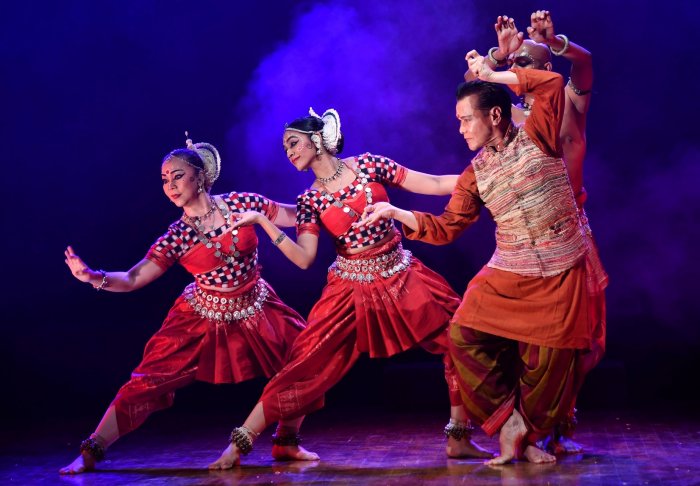 Ramli Ibrahim & Sutra ensemble A powerful chauka, postures and frozen moments balanced on one leg, with the other tracing space in leisure orbits, and rhythm with the recitative Sabda Swara Patha came into full play in the Sthai. The old music recorded with Debaprasad himself powerfully voicing the 'ukkutas' had an authentic vibe, taking one, who had witnessed those days to the past in the fifties. In Sthai, what sounded like Guru Gajendra Panda's voice, the pace was faster - but the dancing with three dancers spaced in different combinations, the performance was very spirited and involved. In a complete counter point to all this verve came the ashtapadi Lalita Lavangalata describing Hari dancing with the young women, in the air filled with the aroma of Spring with the wind carrying fine pollen shaken from newly blossomed jasmine and tender buds in bloom - inducing young women to abandon modesty - indeed a harsh time for deserted lovers! With just three dancers, the feel of sringar in the air was captured. The Sutra performance ended with Suryashtakam, with a final image of the Sun God driving his horse chariot. The standing ovation of the gathering at ADA Rangamandira, was a fitting tribute to a performance combining power with aesthetics. 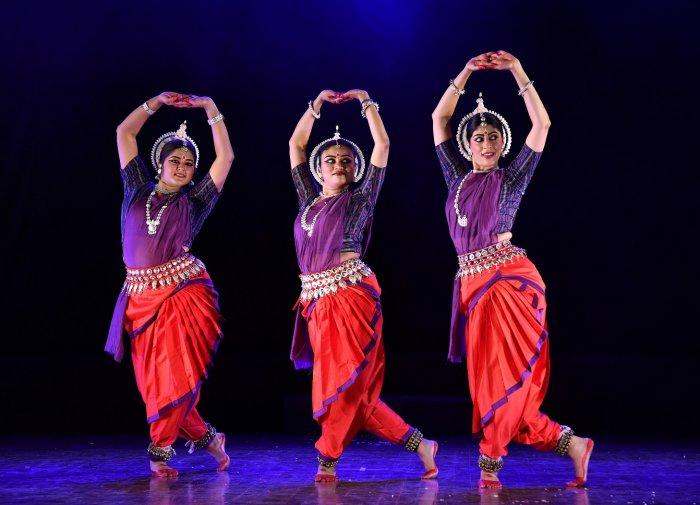 Odissi Dance Centre Students of Devjani Sen's Odissi Dance Centre, taking the stage after Sutra's performance, in a Rasamanjari Pallavi were at a disadvantage, and perhaps the programming could have accommodated them in the earlier slot and made Sutra's presentation the day's concluding programme.  Writing on the dance scene for the last forty years, Leela Venkataraman's incisive comments on performances of all dance forms, participation in dance discussions both in India and abroad, and as a regular contributor to Hindu Friday Review, journals like Sruti and Nartanam, makes her voice respected for its balanced critiquing. She is the author of several books like Indian Classical dance: Tradition in Transition, Classical Dance in India and Indian Classical dance: The Renaissance and Beyond. Post your comments Pl provide your name and email id along with your comment. All appropriate comments posted with name and email id in the blog will also be featured in the site. |